八年级英语阅读拓展课教案
- 格式:doc
- 大小:26.00 KB
- 文档页数:4
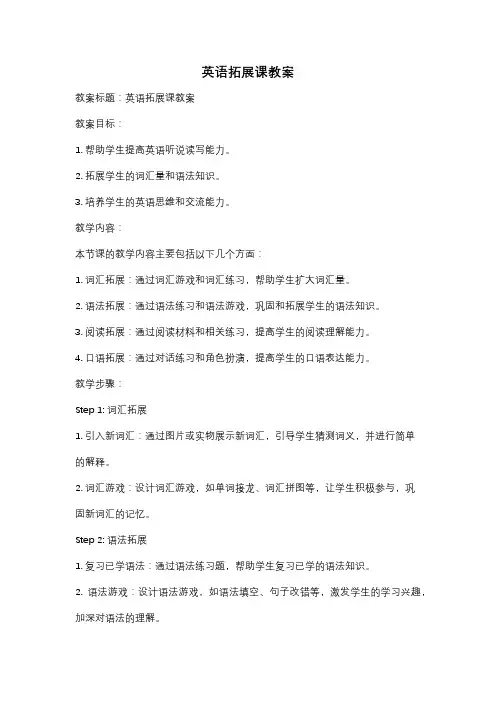
英语拓展课教案教案标题:英语拓展课教案教案目标:1. 帮助学生提高英语听说读写能力。
2. 拓展学生的词汇量和语法知识。
3. 培养学生的英语思维和交流能力。
教学内容:本节课的教学内容主要包括以下几个方面:1. 词汇拓展:通过词汇游戏和词汇练习,帮助学生扩大词汇量。
2. 语法拓展:通过语法练习和语法游戏,巩固和拓展学生的语法知识。
3. 阅读拓展:通过阅读材料和相关练习,提高学生的阅读理解能力。
4. 口语拓展:通过对话练习和角色扮演,提高学生的口语表达能力。
教学步骤:Step 1: 词汇拓展1. 引入新词汇:通过图片或实物展示新词汇,引导学生猜测词义,并进行简单的解释。
2. 词汇游戏:设计词汇游戏,如单词接龙、词汇拼图等,让学生积极参与,巩固新词汇的记忆。
Step 2: 语法拓展1. 复习已学语法:通过语法练习题,帮助学生复习已学的语法知识。
2. 语法游戏:设计语法游戏,如语法填空、句子改错等,激发学生的学习兴趣,加深对语法的理解。
Step 3: 阅读拓展1. 阅读材料选择:选择适合学生水平的英语阅读材料,如短文、故事等。
2. 阅读理解练习:设计相关的阅读理解题目,帮助学生提高阅读理解能力。
Step 4: 口语拓展1. 对话练习:设计情境对话,让学生进行对话练习,提高口语表达能力。
2. 角色扮演:分组进行角色扮演,让学生在模拟场景中运用所学知识进行交流。
教学评估:1. 课堂练习:通过课堂练习,检查学生对词汇、语法、阅读等方面的掌握情况。
2. 口语表达:观察学生在对话和角色扮演中的口语表达能力,给予适当的评价和指导。
教学延伸:1. 课外拓展:鼓励学生在课外进行更多的英语拓展学习,如阅读英语原版书籍、参加英语角等。
2. 听力训练:建议学生进行英语听力训练,提高听力理解能力。
教学资源:1. 词汇卡片、图片或实物2. 语法练习题和游戏材料3. 阅读材料和相关练习题4. 对话和角色扮演情境卡片教学反思:在教学过程中,要注重培养学生的学习兴趣和积极参与度。

初中英语拓展性阅读教案一、教学目标1. 让学生通过拓展性阅读,提高英语阅读理解能力,增加词汇量。
2. 培养学生对英语阅读的兴趣,提高学生的英语综合素质。
3. 通过阅读,使学生了解不同文化背景,拓宽视野。
二、教学内容1. 选择适合初中生阅读的英语文章,难度适中,激发学生的阅读兴趣。
2. 文章内容涵盖不同主题,如:人物传记、科普知识、文学作品、社会现象等。
3. 每篇文章后附有阅读理解题目,帮助学生检验阅读效果。
三、教学方法1. 任务型教学法:教师为学生设定阅读任务,引导学生主动寻找答案。
2. 互动式教学法:教师与学生就文章内容进行讨论,提高学生的参与度。
3. 小组合作学习:学生分组阅读文章,共同完成阅读任务。
四、教学步骤1. 导入:教师简要介绍文章主题,激发学生阅读兴趣。
2. 自读:学生独立阅读文章,理解文章大意。
3. 检查:教师提问,了解学生阅读情况,解答学生疑问。
4. 讨论:学生就文章内容进行讨论,分享阅读心得。
五、教学评价1. 学生阅读理解题目的完成情况,检验学生的阅读效果。
2. 学生参与讨论的积极性,评价学生的课堂表现。
3. 学生阅读笔记和心得体会的质量,评估学生的阅读能力。
六、教学策略1. 引入图片、视频等多媒体资源,增强阅读材料的趣味性。
2. 提供词汇辅助工具,如词典、电子翻译软件等,帮助学生克服阅读障碍。
3. 定期举办阅读分享会,鼓励学生展示自己的阅读成果。
4. 结合课程内容,设计与文章相关的写作任务,提高学生的综合运用能力。
七、教学资源1. 英语原著书籍、简易英语读物、英语杂志、英语新闻等。
2. 网络资源,如英语学习网站、在线英语阅读平台等。
3. 英语学习软件,如英语听力、阅读APP等。
4. 英语阅读资料包,包含各类文章、阅读理解题目及答案解析。
八、教学进度安排1. 每周安排一节拓展性阅读课,保证学生有足够的时间进行阅读和讨论。
2. 每节课阅读一篇篇文章,确保学生充分理解和吸收文章内容。
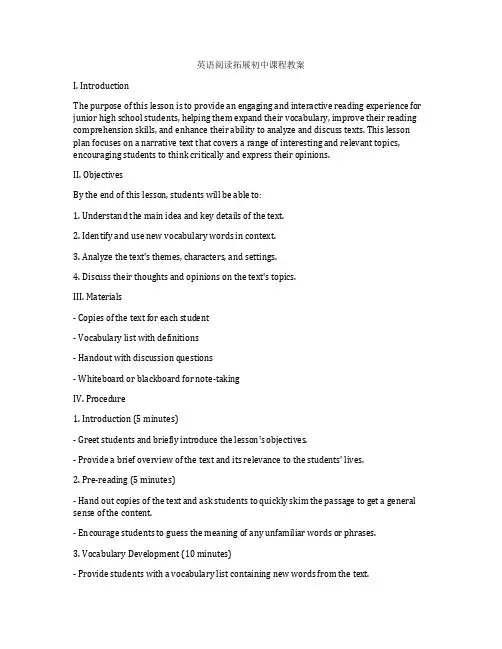
英语阅读拓展初中课程教案I. IntroductionThe purpose of this lesson is to provide an engaging and interactive reading experience for junior high school students, helping them expand their vocabulary, improve their reading comprehension skills, and enhance their ability to analyze and discuss texts. This lesson plan focuses on a narrative text that covers a range of interesting and relevant topics, encouraging students to think critically and express their opinions.II. ObjectivesBy the end of this lesson, students will be able to:1. Understand the main idea and key details of the text.2. Identify and use new vocabulary words in context.3. Analyze the text's themes, characters, and settings.4. Discuss their thoughts and opinions on the text's topics.III. Materials- Copies of the text for each student- Vocabulary list with definitions- Handout with discussion questions- Whiteboard or blackboard for note-takingIV. Procedure1. Introduction (5 minutes)- Greet students and briefly introduce the lesson's objectives.- Provide a brief overview of the text and its relevance to the students' lives.2. Pre-reading (5 minutes)- Hand out copies of the text and ask students to quickly skim the passage to get a general sense of the content.- Encourage students to guess the meaning of any unfamiliar words or phrases.3. Vocabulary Development (10 minutes)- Provide students with a vocabulary list containing new words from the text.- Allow students to work in pairs to match each word with its definition.- Discuss the meaning of each word and provide examples of how to use them in sentences.4. Reading Comprehension (15 minutes)- Ask students to read the text carefully and answer comprehension questions.- Provide a handout with discussion questions related to the text's themes, characters, and settings.- Encourage students to actively engage with the text and think critically about the topics discussed.5. Group Discussion (10 minutes)- Divide students into small groups and ask them to discuss their answers to the comprehension and discussion questions.- Encourage students to share their thoughts, opinions, and personal experiences related to the text's topics.- Provide guidance and support as needed, facilitating a meaningful and respectful discussion.6. whole-class wrap-up (10 minutes)- Ask each group to share their key findings and insights from the discussion.- Encourage students to ask questions or provide additional comments on the text.- Summarize the main points discussed and highlight important concepts or themes.7. Extension Activity (10 minutes)- Assign a related writing or creative task, such as writing a response to the text or creating a visual representation of the story.- Allow students to work independently or in pairs, using the text and their discussions as a reference.V. ConclusionIn this lesson, students were exposed to an engaging reading text that covered relevant and thought-provoking topics. Through vocabulary development, reading comprehension, and group discussions, students were able to analyze the text, expand their vocabulary, and express their thoughts and opinions. The extension activity allowed students to further practice their skills and apply their knowledge, fostering a love for reading and critical thinking.。
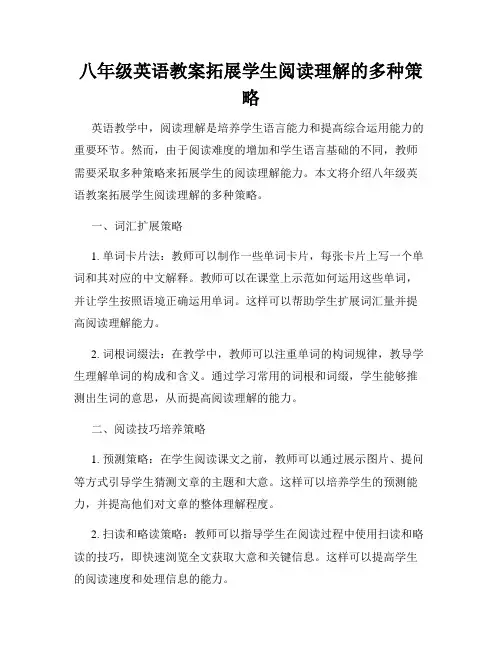
八年级英语教案拓展学生阅读理解的多种策略英语教学中,阅读理解是培养学生语言能力和提高综合运用能力的重要环节。
然而,由于阅读难度的增加和学生语言基础的不同,教师需要采取多种策略来拓展学生的阅读理解能力。
本文将介绍八年级英语教案拓展学生阅读理解的多种策略。
一、词汇扩展策略1. 单词卡片法:教师可以制作一些单词卡片,每张卡片上写一个单词和其对应的中文解释。
教师可以在课堂上示范如何运用这些单词,并让学生按照语境正确运用单词。
这样可以帮助学生扩展词汇量并提高阅读理解能力。
2. 词根词缀法:在教学中,教师可以注重单词的构词规律,教导学生理解单词的构成和含义。
通过学习常用的词根和词缀,学生能够推测出生词的意思,从而提高阅读理解的能力。
二、阅读技巧培养策略1. 预测策略:在学生阅读课文之前,教师可以通过展示图片、提问等方式引导学生猜测文章的主题和大意。
这样可以培养学生的预测能力,并提高他们对文章的整体理解程度。
2. 扫读和略读策略:教师可以指导学生在阅读过程中使用扫读和略读的技巧,即快速浏览全文获取大意和关键信息。
这样可以提高学生的阅读速度和处理信息的能力。
三、语篇理解策略1. 上下文推测策略:教师可以引导学生通过上下文推测生词的意思。
在阅读过程中,教师可以通过提问等方式激发学生的思考,帮助他们理解句子和段落的含义。
2. 段落梳理策略:教师可以教导学生如何将文章分段分句,理清段落之间的逻辑关系。
通过培养学生整体理解的能力,提高他们对文章结构和内容的把握。
四、阅读材料选择策略1. 多样化阅读材料:教师在教学中可以选择多样化的阅读材料,包括新闻、科普文章、故事等,以满足学生的不同阅读需求和兴趣爱好,激发学生的学习兴趣和阅读欲望。
2. 综合阅读任务:教师可以设计一些综合性的阅读任务,要求学生同时掌握文章的主旨大意、细节信息以及作者意图等不同层次的理解。
这样能够提高学生的综合运用能力和分析能力。
综上所述,八年级英语教案拓展学生阅读理解的多种策略包括词汇扩展策略、阅读技巧培养策略、语篇理解策略以及阅读材料选择策略。
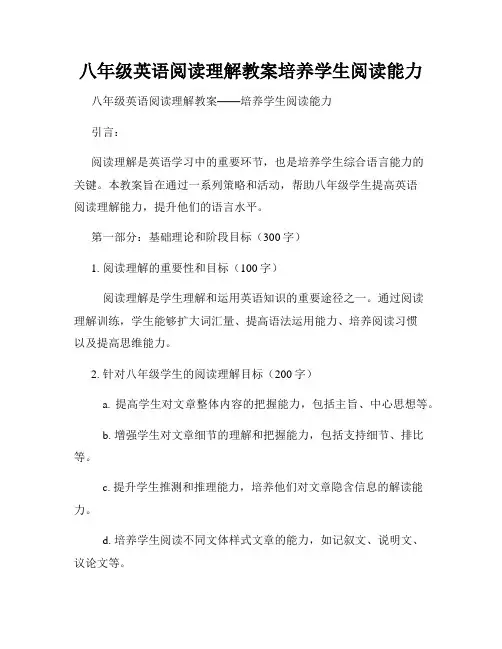
八年级英语阅读理解教案培养学生阅读能力八年级英语阅读理解教案——培养学生阅读能力引言:阅读理解是英语学习中的重要环节,也是培养学生综合语言能力的关键。
本教案旨在通过一系列策略和活动,帮助八年级学生提高英语阅读理解能力,提升他们的语言水平。
第一部分:基础理论和阶段目标(300字)1. 阅读理解的重要性和目标(100字)阅读理解是学生理解和运用英语知识的重要途径之一。
通过阅读理解训练,学生能够扩大词汇量、提高语法运用能力、培养阅读习惯以及提高思维能力。
2. 针对八年级学生的阅读理解目标(200字)a. 提高学生对文章整体内容的把握能力,包括主旨、中心思想等。
b. 增强学生对文章细节的理解和把握能力,包括支持细节、排比等。
c. 提升学生推测和推理能力,培养他们对文章隐含信息的解读能力。
d. 培养学生阅读不同文体样式文章的能力,如记叙文、说明文、议论文等。
第二部分:教学策略和活动设计(800字)1. 激发学生兴趣:通过引入有趣的话题、图片或视频激发学生的兴趣,并提出问题引导学生思考。
2. 词汇与语法支持:在阅读前预习时,引导学生查找和了解关键词汇和句型,以便更好地理解文章。
3. 预测和猜测:在阅读前,通过标题、副标题、图片等帮助学生猜测文章内容,并引导他们提出几个问题以激发好奇心。
4. 细节理解:指导学生通过划线、圈出关键词句、进行标记等方式,帮助他们快速捕捉文章中的细节信息。
5. 主旨把握:引导学生通过找出文章的中心句或主题句,理解文章的主旨,并结合细节提供相关支持。
6. 隐含信息理解:通过提问或引导学生在文章中寻找线索,培养他们对隐含信息的分析和解读能力。
7. 文体样式分析:指导学生通过观察文章的结构、段落、语言特点等分析文章的文体样式,并结合阅读理解题目进行答题。
第三部分:教学实施和评估(400字)1. 实施步骤:a. 教师介绍或复习相关的阅读理解知识和策略。
b. 学生阅读一篇文章,按照教师提供的策略分析和理解文章。
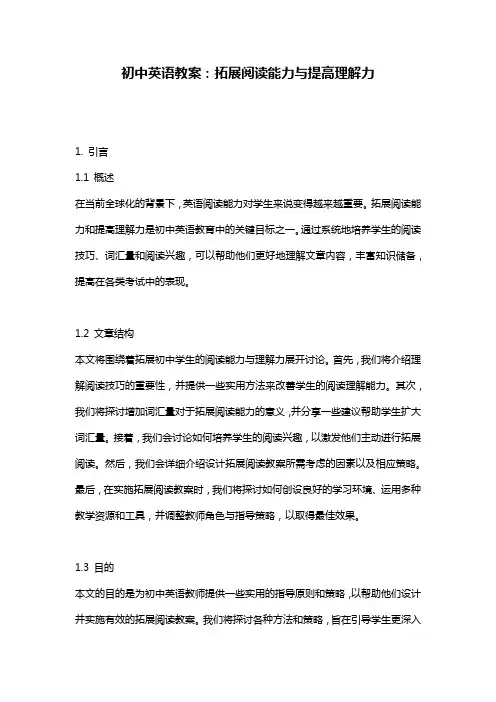
初中英语教案:拓展阅读能力与提高理解力1. 引言1.1 概述在当前全球化的背景下,英语阅读能力对学生来说变得越来越重要。
拓展阅读能力和提高理解力是初中英语教育中的关键目标之一。
通过系统地培养学生的阅读技巧、词汇量和阅读兴趣,可以帮助他们更好地理解文章内容,丰富知识储备,提高在各类考试中的表现。
1.2 文章结构本文将围绕着拓展初中学生的阅读能力与理解力展开讨论。
首先,我们将介绍理解阅读技巧的重要性,并提供一些实用方法来改善学生的阅读理解能力。
其次,我们将探讨增加词汇量对于拓展阅读能力的意义,并分享一些建议帮助学生扩大词汇量。
接着,我们会讨论如何培养学生的阅读兴趣,以激发他们主动进行拓展阅读。
然后,我们会详细介绍设计拓展阅读教案所需考虑的因素以及相应策略。
最后,在实施拓展阅读教案时,我们将探讨如何创设良好的学习环境、运用多种教学资源和工具,并调整教师角色与指导策略,以取得最佳效果。
1.3 目的本文的目的是为初中英语教师提供一些实用的指导原则和策略,以帮助他们设计并实施有效的拓展阅读教案。
我们将探讨各种方法和策略,旨在引导学生更深入地理解英语阅读材料,并提高他们的阅读能力与理解力。
通过本文所提供的建议和提示,希望能够激发教师们对于拓展阅读教育的思考,促进教育改革与创新,在营造积极有益的英语学习环境中,培养出更多具有出色阅读与理解能力的学生。
2. 拓展阅读能力与提高理解力2.1 理解阅读技巧拓展阅读能力的关键是提高理解力,学生需要掌握一些有效的阅读技巧。
首先,他们应该学会预测故事情节和推测词义。
通过观察上下文并利用已有的词汇知识,学生可以猜测出不熟悉的单词或句子的含义。
其次,学生需要注意文章中的关键信息,如人物名字、时间地点等,并理解它们在整个故事中的作用和关系。
此外,学生还应该培养区分重要细节和次要细节的能力,从而更好地理解文章的主旨。
2.2 增加词汇量为了更好地理解拓展阅读材料,学生需要不断扩大自己的词汇量。
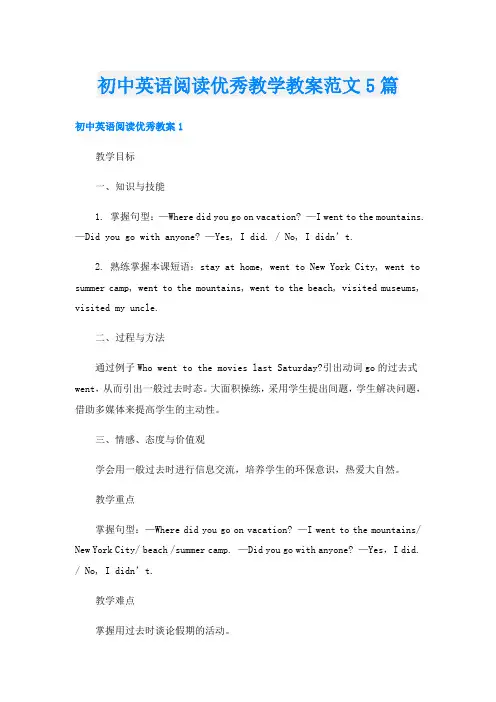
初中英语阅读优秀教学教案范文5篇初中英语阅读优秀教案1教学目标一、知识与技能1. 掌握句型:—Where did you go on vacation? —I went to the mountains. —Did you go with anyone? —Yes, I did. / No, I didn’t.2. 熟练掌握本课短语:stay at home, went to New York City, went to summer camp, went to the mountains, went to the beach, visited museums, visited my uncle.二、过程与方法通过例子Who went to the movies last Saturday?引出动词go的过去式went,从而引出一般过去时态。
大面积操练,采用学生提出间题,学生解决问题,借助多媒体来提高学生的主动性。
三、情感、态度与价值观学会用一般过去时进行信息交流,培养学生的环保意识,热爱大自然。
教学重点掌握句型:—Where did you go on vacation? —I went to the mountains/ New York City/ beach /summer camp. —Did you go with anyone? —Yes,I did. / No, I didn’t.教学难点掌握用过去时谈论假期的活动。
教法导航通过看图、看视频、听录音、问答、讨论等方法学习谈论能力和表达愿望。
学法导航通过看、听、说等各种途径,以小组合作的形式,主动探求知识,锻炼自主学习能力。
教学准备图片,多媒体。
教学过程Step 1 GreetingsGreet the class.Step 2 Lead inAsk questions about what students did last Saturday.(1)Who went to the movies last Saturday? Point to one student who raises his or her hand. Sara went to the movies last Saturday. Repeat.Write this sentence on the board.Underline the word went.(2)Ask:Who visited a friend last Saturday?Point to one student who raises his or her hand.Carlos visited a friend last Saturday.Repeat. Write this sentence on the board. Underline the word “visited”.Point to the words went and visited in the sentences on the board.Say:We use these words to talk about things that happened in the past. Writethese pairs of words on the board:go–went, visit –visited. Ask: Can you point out the words that talk about the past?This activity introduces the key vocabulary.Step 3 Practice1. Focus attention on the picture.Ask: What can you see?Say: Each picture shows something a person did in the each activity and ask students to repeat: went to the mountains, went to New York City, went to summer camp, visited my uncle,stayed at home, went to the beach, visited museums.2.Point to the numbered list of activities.Say each one again and ask the students to repeat.3.Now, please match each phrase with one of the pictures.Say:Write the letter of each picture next to the name of the activity.Point to the sample answer.4.Check the answers.Step 4 Listening1.Point to the picture on the screen. Say: look at Picture A,Where did Tina go on vacation? Yes,she went to the mountains.Ask:What did the person do in each scene? Say: There are three conversations. Play the recording the first time.2. The people talk about what they did on vacation.Listen to the recording and write numbers of the names in the right boxes in the picture.Please write only 5 numbers. Point out the sample answer next to the picture showing went to the mountain. Play the recording a second time.3.Correct the answers.Step 5 Pair workPoint out the example conversation. Ask two students to read the dialogue to the class. Say the dialogue in the picture with a student,Do a second example to the class. Then say:Now work with a partner, make conversations about the people in the pictures.As they talk,move around the classroom monitoring their work. Offer language or pronunciation support as needed.Step 6 Listening1.2a. Ask: Where did the people go on vacation? And then ask the students to listen carefully and fill in the chart. Play the recording twice and then check the answers.2. Look at the form carefully, ask: Did the people do the following things? Then ask thestudents to listen carefully and check the anwers. Play twice and ask the students to check the answers in pairs and then check the answers together.Step 7 Role playLook at the form again carefully and make role-play conversations among Grace, Kevin and Julie. Ask one or two groups to show the conversation first and then get the students to practice in groups.初中英语阅读优秀教案2教学目标学习打招呼的用语,询问姓名和相互间的问候。
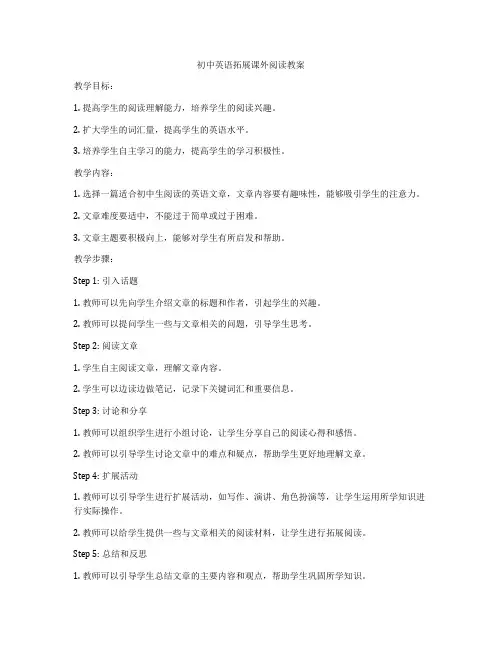
初中英语拓展课外阅读教案教学目标:1. 提高学生的阅读理解能力,培养学生的阅读兴趣。
2. 扩大学生的词汇量,提高学生的英语水平。
3. 培养学生自主学习的能力,提高学生的学习积极性。
教学内容:1. 选择一篇适合初中生阅读的英语文章,文章内容要有趣味性,能够吸引学生的注意力。
2. 文章难度要适中,不能过于简单或过于困难。
3. 文章主题要积极向上,能够对学生有所启发和帮助。
教学步骤:Step 1: 引入话题1. 教师可以先向学生介绍文章的标题和作者,引起学生的兴趣。
2. 教师可以提问学生一些与文章相关的问题,引导学生思考。
Step 2: 阅读文章1. 学生自主阅读文章,理解文章内容。
2. 学生可以边读边做笔记,记录下关键词汇和重要信息。
Step 3: 讨论和分享1. 教师可以组织学生进行小组讨论,让学生分享自己的阅读心得和感悟。
2. 教师可以引导学生讨论文章中的难点和疑点,帮助学生更好地理解文章。
Step 4: 扩展活动1. 教师可以引导学生进行扩展活动,如写作、演讲、角色扮演等,让学生运用所学知识进行实际操作。
2. 教师可以给学生提供一些与文章相关的阅读材料,让学生进行拓展阅读。
Step 5: 总结和反思1. 教师可以引导学生总结文章的主要内容和观点,帮助学生巩固所学知识。
2. 教师可以反思本次阅读活动的效果,找出不足之处,为下一次活动做好准备。
教学评价:1. 观察学生在阅读过程中的表现,如阅读速度、阅读理解能力等。
2. 听取学生的反馈意见,了解学生的学习需求和兴趣。
3. 通过学生的扩展活动成果,评估学生的学习效果。
注意事项:1. 教师要关注学生的个体差异,给予不同水平的学生不同的指导和帮助。
2. 教师要鼓励学生积极参与阅读活动,培养学生的阅读习惯。
3. 教师要注重阅读材料的筛选,确保文章的质量。
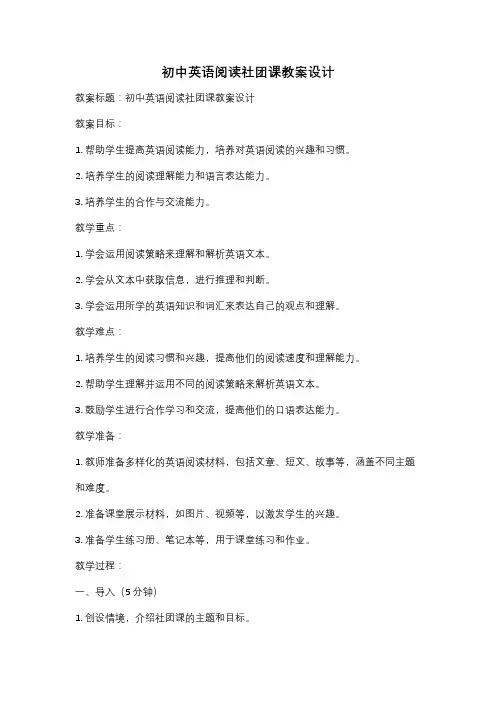
初中英语阅读社团课教案设计教案标题:初中英语阅读社团课教案设计教案目标:1. 帮助学生提高英语阅读能力,培养对英语阅读的兴趣和习惯。
2. 培养学生的阅读理解能力和语言表达能力。
3. 培养学生的合作与交流能力。
教学重点:1. 学会运用阅读策略来理解和解析英语文本。
2. 学会从文本中获取信息,进行推理和判断。
3. 学会运用所学的英语知识和词汇来表达自己的观点和理解。
教学难点:1. 培养学生的阅读习惯和兴趣,提高他们的阅读速度和理解能力。
2. 帮助学生理解并运用不同的阅读策略来解析英语文本。
3. 鼓励学生进行合作学习和交流,提高他们的口语表达能力。
教学准备:1. 教师准备多样化的英语阅读材料,包括文章、短文、故事等,涵盖不同主题和难度。
2. 准备课堂展示材料,如图片、视频等,以激发学生的兴趣。
3. 准备学生练习册、笔记本等,用于课堂练习和作业。
教学过程:一、导入(5分钟)1. 创设情境,介绍社团课的主题和目标。
2. 引导学生回顾之前所学的阅读策略和技巧。
二、阅读活动(30分钟)1. 提供一篇适合初中学生阅读的英语文章。
2. 学生个人默读,了解文章的大意和主题。
3. 学生小组合作,讨论文章中的生词和不熟悉的句子,互相解释和帮助。
4. 教师引导学生运用不同的阅读策略,如预测、推理、判断等,来解析和理解文章。
5. 学生个人或小组完成相关的阅读理解题目,检查理解程度。
三、语言表达(15分钟)1. 学生个人或小组分享对文章的理解和观点。
2. 教师引导学生运用所学的英语知识和词汇来表达自己的观点和理解。
3. 学生之间进行互动交流,提出问题和回答问题。
四、拓展活动(10分钟)1. 提供其他相关阅读材料,让学生继续阅读和理解。
2. 学生个人或小组完成相关的练习和任务。
3. 教师提供反馈和指导,帮助学生进一步提高阅读能力。
五、总结和反思(5分钟)1. 教师总结本节课的重点和难点,并进行复习。
2. 学生反思自己在本节课中的学习收获和困难。
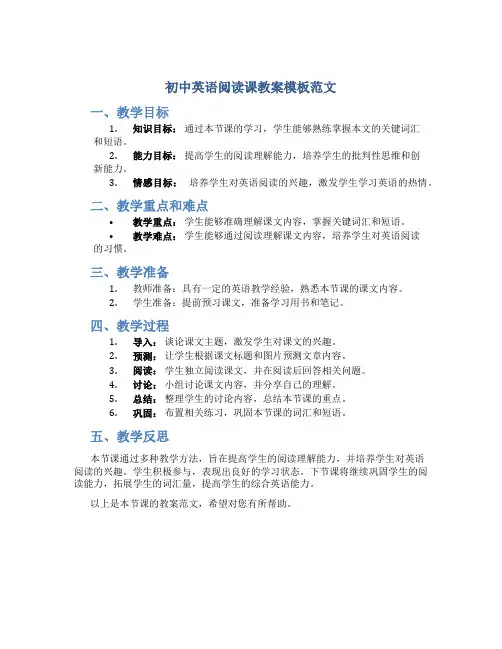
初中英语阅读课教案模板范文
一、教学目标
1.知识目标:通过本节课的学习,学生能够熟练掌握本文的关键词汇
和短语。
2.能力目标:提高学生的阅读理解能力,培养学生的批判性思维和创
新能力。
3.情感目标:培养学生对英语阅读的兴趣,激发学生学习英语的热情。
二、教学重点和难点
•教学重点:学生能够准确理解课文内容,掌握关键词汇和短语。
•教学难点:学生能够通过阅读理解课文内容,培养学生对英语阅读的习惯。
三、教学准备
1.教师准备:具有一定的英语教学经验,熟悉本节课的课文内容。
2.学生准备:提前预习课文,准备学习用书和笔记。
四、教学过程
1.导入:谈论课文主题,激发学生对课文的兴趣。
2.预测:让学生根据课文标题和图片预测文章内容。
3.阅读:学生独立阅读课文,并在阅读后回答相关问题。
4.讨论:小组讨论课文内容,并分享自己的理解。
5.总结:整理学生的讨论内容,总结本节课的重点。
6.巩固:布置相关练习,巩固本节课的词汇和短语。
五、教学反思
本节课通过多种教学方法,旨在提高学生的阅读理解能力,并培养学生对英语
阅读的兴趣。
学生积极参与,表现出良好的学习状态。
下节课将继续巩固学生的阅读能力,拓展学生的词汇量,提高学生的综合英语能力。
以上是本节课的教案范文,希望对您有所帮助。
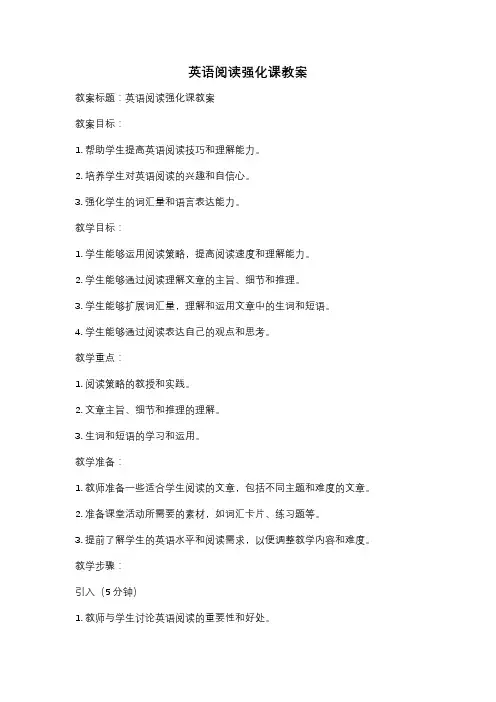
英语阅读强化课教案教案标题:英语阅读强化课教案教案目标:1. 帮助学生提高英语阅读技巧和理解能力。
2. 培养学生对英语阅读的兴趣和自信心。
3. 强化学生的词汇量和语言表达能力。
教学目标:1. 学生能够运用阅读策略,提高阅读速度和理解能力。
2. 学生能够通过阅读理解文章的主旨、细节和推理。
3. 学生能够扩展词汇量,理解和运用文章中的生词和短语。
4. 学生能够通过阅读表达自己的观点和思考。
教学重点:1. 阅读策略的教授和实践。
2. 文章主旨、细节和推理的理解。
3. 生词和短语的学习和运用。
教学准备:1. 教师准备一些适合学生阅读的文章,包括不同主题和难度的文章。
2. 准备课堂活动所需要的素材,如词汇卡片、练习题等。
3. 提前了解学生的英语水平和阅读需求,以便调整教学内容和难度。
教学步骤:引入(5分钟)1. 教师与学生讨论英语阅读的重要性和好处。
2. 引导学生分享自己的阅读经验和困惑。
阅读策略教授(10分钟)1. 教师介绍不同的阅读策略,如预测、扫读、略读和细读等。
2. 解释每种策略的用途和操作方法。
3. 给学生提供实际的阅读例子,演示如何运用不同的策略。
阅读理解训练(20分钟)1. 学生独立阅读一篇适合自己水平的文章。
2. 学生回答与文章相关的主旨、细节和推理问题。
3. 教师提供指导和反馈,帮助学生理解和解答问题。
词汇扩展(15分钟)1. 教师选择文章中的一些生词和短语,解释其意思和用法。
2. 学生通过词汇卡片或练习题等方式进行词汇学习和巩固。
3. 学生尝试在文章中运用新学的词汇和短语。
思考和表达(10分钟)1. 学生就所读文章的主题或观点进行思考和讨论。
2. 学生以小组或个人形式表达自己的观点和理由。
3. 教师引导学生使用正确的语言表达和提供反馈。
总结和反思(5分钟)1. 教师与学生一起总结本节课所学的阅读策略和技巧。
2. 学生反思自己的阅读进步和困难,并提出问题和建议。
拓展活动:1. 学生可以通过阅读英文小说、报纸或杂志等来进一步提高阅读能力。
《拓展拓展想象力的英语八年级下册Unit5SectionA课堂延伸
教案》。
通过听力训练,学生可以更好地了解并记忆掌握词汇和句子。
教师可以播放录音文件,让学生先听一遍,了解主要内容和关键词汇,然后再进行有针对性地听力练习。
教师可以让学生带着问题进行听,提高听力的效率。
例如,教师可以提问:“What does the girl have for breakfast?”或者“Where does she put her bag?”这样可以帮助学生更好地记录下听到的内容,提高听力理解和记忆力。
通过口语练习,学生可以更好地表达自己的想法和感受,同时提高交流效率,这对于英语学习非常重要。
教师可以分组进行对话练习,让学生在小组内互相讲述自己的一天,然后进行分享。
也可以让学生对课文中的内容进行口语表达,从而巩固课文记忆,掌握英语语言、习惯和文化。
除此之外,本教案还涉及阅读和写作的训练。
在阅读方面,教师可以让学生阅读与课本主题相关的文章,并进行阅读理解的测试,帮助学生快速掌握读懂英语文章的技巧和方法。
在写作方面,教师可以引导学生依据自身经历或其他材料,撰写短文或表述想法,更好地使用英语语言,从而培养学生英语写作能力和思考能力。
教师可以通过多种教学方法,让学生更好地掌握课本上的知识点,并且在语言表达上有所拓展,提高英语水平。
教师还可以根据学
生的实际情况,进行个性化的教育和辅导,提高学生学习英语的积极性和学习效果。
八年级英语阅读课公开课以下是一份关于八年级英语阅读课的公开课教案,供您参考:课程名称:八年级英语阅读课教学目标:1. 提高学生阅读理解能力2. 增强学生词汇量和语法知识3. 培养学生阅读兴趣和阅读习惯教学内容:1. 阅读技巧讲解2. 阅读材料分析和讨论3. 词汇和语法讲解4. 阅读练习和巩固教学步骤:1. 导入(5分钟)教师介绍阅读的重要性和作用,引导学生认识到阅读是获取信息和提高语言能力的有效途径。
教师引导学生分享自己的阅读经验和感受,激发学生学习兴趣。
2. 阅读技巧讲解(10分钟)教师讲解阅读的基本技巧,如预测、推理、略读、扫读等。
教师通过实例和练习,帮助学生理解并掌握阅读技巧。
3. 阅读材料分析和讨论(20分钟)教师选择适合学生水平的阅读材料,引导学生进行阅读。
教师组织学生分组讨论,分析阅读材料中的主题、观点、词汇和语法等。
教师鼓励学生发表自己的看法和见解,培养学生的批判性思维和表达能力。
4. 词汇和语法讲解(15分钟)教师针对阅读材料中的重点词汇和语法进行讲解,帮助学生掌握相关知识点。
教师设计词汇和语法练习,巩固所学知识,提高运用能力。
5. 阅读练习和巩固(20分钟)教师提供相关阅读练习,让学生运用所学阅读技巧和词汇、语法知识进行实践。
教师引导学生独立完成练习,并鼓励学生互相讨论和交流。
教师对学生的练习进行点评和总结,指出存在的问题和改进的方向。
6. 课堂总结(5分钟)教师总结本节课所学内容,强调阅读的重要性和实用性。
教师引导学生回顾所学阅读技巧、词汇和语法知识,巩固记忆。
八年级英语阅读课教案5篇八年级英语阅读课教案5篇作为一名老师,编写教案是必不可少的,编写教案助于积累教学经验,不断提高教学质量。
下面是小编为大家整理的八年级英语阅读课教案,如果大家喜欢可以分享给身边的朋友。
八年级英语阅读课教案篇1一.教材内容分析本模块以太空之旅为话题,着重介绍了火星探索以及宇宙中太阳系的部分知识。
要求同学们能够了解一些有关航天知识,用现在完成时去描述人类已经实施的太空探索。
二.学情分析在前一个模块中,学生初步掌握了利用现在完成时态谈论,旅游、看电影、看书等经历,学习了现在完成时的一般疑问句及肯定、否定的回答方法。
在本模块中,学生将继续学习yet, already, just等词在现在完成时态中的用法及have been to与have gone to之间的区别。
学习了现在完成时的一般疑问句及肯定、否定的回答方法。
人类对宇宙的探索,是否真的存在外星人,太空旅行……这些是初中生们非常感兴趣的话题,学生会觉得有话可说。
但是这一话题涉及较多的词汇,学生掌握的难度较大。
所以可能会导致学生有话想说,但却无法用英语来表达的尴尬场面。
所以在具体安排教学内容时,应适当降低难度与要求,通过开展生动有趣的活动将航天知识和语法知识深入浅出的传授给学生。
三.教学方法:直观法,小组活动法。
四.学习方法:自主学习,合作学习,探究。
五.教学目标:1.知识目标:能够掌握关于宇宙及航天的词汇;掌握现在完成时的用法2.能力目标:能听懂有关太空旅行的介绍,能够读懂有关太空话题的文章,掌握文章大意能够运用现在完成时态描述人类太空探索计划。
3.情感目标:开展生动活泼的教学活动,激发学生学习英语的兴趣。
了解中国航空事业发展,增强民族自豪感。
4.教学重点:①重点词汇:earth, just, already, station, recently, planet等.②重点句型:---Have you ….yet---Yes, I have already / just…---No, I haven’t…yet.---I have been to… He / She has gone to…5.教学难点:①用现在完成时态来描述人类已实施的太空探索计划。
培养学生阅读理解能力的八年级英语教案(以下为文章正文)教案一:培养学生阅读理解能力的八年级英语教案教学目标:1. 帮助学生提高阅读理解能力,包括正确把握文章主旨,理解文章细节,推理文章意义等。
2. 培养学生对不同类型文章的阅读理解能力,包括记叙文、说明文、议论文等。
3. 提升学生的阅读速度和思维能力,培养对英语文章的兴趣。
教学内容:1. 阅读理解技巧的介绍:a. 找出主题句:帮助学生快速抓住文章的主旨。
b. 理解词汇:学习通过上下文推断单词或短语的含义。
c. 分析文章结构:帮助学生理解文章的脉络及段落间的逻辑关系。
d. 推断文章意义:引导学生根据线索推测作者的意图或读者的情感。
e. 制定阅读计划:教导学生如何合理安排时间,提高阅读效率。
2. 阅读材料的选择和设计:a. 选择不同类型的文章,如记叙文、说明文和议论文,以便学生接触不同风格和结构的英语材料。
b. 根据学生的英语水平,选择合适难度的文章。
可从简单到复杂逐渐增加难度。
c. 设计问题和练习,以检测学生对文章的理解程度。
教学步骤:1. 导入:a. 引导学生回顾所学的阅读理解技巧,并进行简单的复习。
b. 提问学生,培养他们对阅读的兴趣,激发学习的动力。
2. 正式教学:a. 分析一篇简单的记叙文,教导学生如何找出主题句。
b. 解释和讲解生词,并引导学生通过上下文推断单词的意思。
c. 教导学生如何分析文章的结构和段落间的逻辑关系。
d. 布置相应的练习,让学生巩固所学知识。
3. 拓展练习:a. 提供一些较复杂的英语材料,如说明文或议论文,引导学生运用所学的阅读理解技巧。
b. 设置不同层次的问题,以满足不同学生的需求。
4. 总结:a. 回顾本堂课的教学内容,强调重要知识点。
b. 确保学生对所学知识的理解和掌握。
c. 鼓励学生多读英语文章,提高阅读能力。
教学评估:1. 课堂练习:a. 给学生布置阅读理解练习题,检测他们对所学知识的掌握情况。
b. 对学生的答案进行讲解和评价。
初中英语拓展性阅读教案教案标题:Exploring the World: Reading for Pleasure教学对象:初中英语学生教学时间:1课时教学目标:1.培养学生们对拓展性阅读的兴趣和习惯。
2.提高学生们的阅读理解能力,包括推理、排除干扰等相关技巧。
3.培养学生们的跨文化交流能力和对英语语言及其他文化的理解。
教学重点:1.提高学生们的阅读理解能力。
2.培养学生们的阅读兴趣和习惯。
教学难点:1.帮助学生们培养阅读的习惯,从而提高阅读能力。
2.帮助学生们理解跨文化交流的重要性,并培养相关的能力。
教学准备:1.教师准备五篇关于不同国家及其文化的文章,每篇约300字。
2.拓展性阅读学生练习册。
3.各种帮助学生们提高阅读理解能力的教学素材,包括练习题、解析等。
教学过程:Step 1:导入(5分钟)教师向学生们介绍拓展性阅读的重要性,以及如何培养拓展性阅读的习惯。
教师可以分享自己的阅读经历,如每天读一篇英语文章,并向学生们推荐一些优秀的英语读物。
Step 2:阅读文章(15分钟)教师将五篇关于不同国家及其文化的文章给学生们阅读。
学生们可以根据自己的阅读能力选择其中的一篇进行阅读。
Step 3:讨论与分享(10分钟)学生们在小组内讨论他们所读文章的主题、中心思想,以及他们所了解到的有趣的事实等。
教师可以引导学生们提出问题和交流,以促进其思考和表达能力的发展。
Step 4:阅读理解练习(15分钟)教师将一份阅读理解练习分发给学生。
学生们需要仔细阅读文后的问题,并根据文章内容选择正确答案。
教师在学生完成练习后,进行相关的解析和答疑。
Step 5:练习册完成(15分钟)学生们根据教师的要求,完成拓展性阅读练习册中的相关练习。
教师可以根据学生们的水平和能力情况,选择适当的练习题目进行布置。
Step 6:总结反馈(5分钟)教师与学生们一起总结当天的学习内容,提问学生们在拓展性阅读过程中所遇到的困难和收获。
并表扬和鼓励学生们的努力。
初中英语阅读课教案第一章:阅读理解基本技巧1.1 教学目标:让学生掌握阅读理解的基本技巧,如略读、寻读、精读等。
培养学生快速获取文章主旨和细节信息的能力。
1.2 教学内容:介绍略读、寻读和精读的定义和作用。
通过实例讲解各种阅读技巧的运用。
1.3 教学活动:讲解略读、寻读和精读的定义和作用。
让学生练习使用这些技巧阅读短文。
讨论学生阅读时遇到的困难和问题,引导学生找到解决方法。
1.4 作业:让学生选择一篇适合自己的英语文章,使用所学的阅读技巧进行阅读。
总结自己在阅读过程中使用的技巧,以及遇到的困难和解决方法。
第二章:词汇理解2.1 教学目标:让学生掌握词汇理解的基本技巧,如根据上下文猜词义、使用词汇联想等。
培养学生通过词汇理解文章的能力。
2.2 教学内容:介绍根据上下文猜词义的方法和注意事项。
讲解词汇联想的概念和运用。
2.3 教学活动:讲解根据上下文猜词义的方法和注意事项。
让学生练习使用词汇联想阅读短文。
讨论学生阅读时遇到的困难和问题,引导学生找到解决方法。
2.4 作业:让学生选择一篇适合自己的英语文章,使用所学的词汇理解技巧进行阅读。
总结自己在阅读过程中使用的技巧,以及遇到的困难和解决方法。
第三章:推理判断3.1 教学目标:让学生掌握推理判断的基本技巧,如通过文章中的细节信息进行推理、判断作者的观点等。
培养学生通过推理判断理解文章的能力。
3.2 教学内容:介绍通过文章中的细节信息进行推理的方法和注意事项。
讲解判断作者观点的方法和注意事项。
3.3 教学活动:讲解通过文章中的细节信息进行推理的方法和注意事项。
让学生练习使用推理判断技巧阅读短文。
讨论学生阅读时遇到的困难和问题,引导学生找到解决方法。
3.4 作业:让学生选择一篇适合自己的英语文章,使用所学的推理判断技巧进行阅读。
总结自己在阅读过程中使用的技巧,以及遇到的困难和解决方法。
第四章:阅读策略4.1 教学目标:让学生掌握常用的阅读策略,如预测、归纳、总结等。
八年级英语分级阅读拓展课教案一一、教材分析(1)教学内容:本课是一堂英语阅读课a letter,文章通过书信的形式介绍了有关Britain的知识,从著名城市、自然风景、气候条件、它的历史和饮食文化等方面,介绍了英国这个国家。
通过本节课的阅读教学,使学生从阅读中获取相关的关于英国的信息,让学生学会对信息的处理和加工,提高学生的综合语言运用能力。
(2)教学目标:①知识目标:了解英国的风土人情和著名城市的特色,增加了词汇量。
②能力目标:培养学生听、说、读和写的能力,尤其是阅读方面的技巧。
通过运用多媒体,培养学生的英语口头表达能力,分析问题和解决问题的能力。
锻炼学生用英语自己组织复述课文。
③情感目标:了解西方的文化,加深对英语的理解和使用,加深对本国文化的理解与认识,培养世界认识,有利于形成跨文化交际能力。
(3)教学重点和难点;掌握重要的单词和短语,充分利于关键词复述课文。
训练学生的Fast reading、careful reading等阅读技能。
(4)教学方法:问答式、任务型阅读三、教学手段:多媒体、图片四、教学过程Step 1: 读前和热身(Pre---reading and warm up)By asking students the following questions, the teacher can raise students′ interest in this topics.(1) What is Britain famous for?(2) When we talk about Britain, what do you think of?(3) Have you ever heard anything interesting about Britain?「设计说明」为了激起学生阅读的兴趣,用幻灯片演示出Britain的景色,给出三个问题,让他们来回答。
既引出了话题,也可练习学生的英语口语和用英语发言的勇气于胆量。
Step 2:导入(Leading in)Present a map of Britain to students by Power Point.T: What is the capital city of Britain and where is it?S:Answer the question and point the position.T: Where is the largest city London, located?Ask some students to answer it.「设计说明」通过多媒体展示Britain的地图,来了解Britain在世界所处的位置,以及它的著名城市在Britain的位置,让学生有一个视觉上的感受,进一步引导学生的欣赏能力,提高他们的阅读兴趣。
Step 3 读中和快速阅读(While reading and Fast reading)Firstly ask some students to read some words on the blackboard.. These words have been studied in the last lesson. Before students read the text, ask some students to think about what subjects will be covered in the passage, Read the passage quickly and answer the following questions.(1) Who did Peter spent a week with?(2) Is it the language that different from England?(3) What are the differences in Britain?「设计说明」首先让一些学生朗读本课中的单词,其中有些是省生单词,这些在上节课中已经领读过了,再次让学生的读单词,既复习了上一堂课的内容,又锻炼了学生的英语口语和胆量。
培养了学生参与阅读的动力,体现了学生的主体地位。
给学生提出任务,带着任务去阅读,帮助学生预测话题,学生只要泛读就能回答这些问题,因为这些问题主要针对文章的主旨大意和比较明显的细节内容。
引导学生分析问题,由浅入深,由感性认识到理性思考,从而降低了阅读难度,为进一步阅读作好充分的准备。
Step 4 精读(careful reading)Part one: Read the details below and choose which ones are true(T),which ones are false(F).( ) 1.Peter has spent two weeks in Britain.( ) 2.Habits in Britain are different .( ) 3. Local habits and tradition are the same in Britain.( ) 4.More Chinese live in Vancouver than in any other city in North America.( ) 5.Many people are proud of their cities in Britain.( ) 6.Peter will tell something more about Britain to Boris「设计说明」通过判断对错题,旨在帮助学生提高他们的发现特别信息的能力,加深对文章的整体与细节的理解,学生学到了这方面的知识,培养了学生获取信息和处理信息的能力。
Part two:竞赛Competition.Divided the students into four groups . Let students have a competition.. Choose the best group. Ask them to read the passage again.. Make sure that students can dist1、English in Britain is ___________from that they learn at school.2、Peter had expected to see_____________ in Britain.3、The best city for sailing and fishing is ___________________.4、The weather in Britain is ______________________.5、Local _________ and ___________ are not as the same as they know.「设计说明」为了改变英语阅读课堂的紧张而又枯燥的课堂气氛,我把全班学生分成四组,每一组正好代表加拿大的四大世界闻名的城市。
给出的五道填空题,是考察学生对文章中的细节与逻辑推理能力。
既有效的训练了在规定的时间内学生的阅读速度,也就是泛读与精读能力,又锻炼了学生的团体合作能力,让学生体验和感受集体主义精神。
根据学生的反映,评出最佳小组,给于适当的表扬和鼓励,同时也加深了学生对文章内容的理解。
Step 5难点处理(difficult points)Write some difficult and new words on the blackboard.. Ask students not to refer to the dictionary or ask me for an explanation every time they come across a new word. .Encourage them to guess the meaning from the context..「设计说明」由于本课教学任务主要是培养学生的阅读技巧,文章中琐碎的语言点我安排在下一课时。
文中的新单词和比较难理解的词汇,我并没要求学生查字典,也没有直接说出他们的汉语意思。
而是鼓励学生根据课文中的具体语境来猜测词的含义。
特别要注意该词所在的前后句子。
这也是为高考做准备,高考每年都要考察学生猜测生词的含义。
Step 6 读后(Post reading):discussionOrganize students into pairs. Each pair may choose to focus on a specific subject about Britain, such as its history , its geography or cities ,based on the reading passage or any other resources they can find. Praise students for any parts they do well in. Try not to focus on their mistakes, as this will discourage students from speaking in front of the class.「设计说明」组织学生根据文章内容或者他们能找到的相关Britain的资料,在课堂上分成小组进行讨论。
话题可以是有关的历史,地理状况,城市等。
学生是讨论的主体,我给予适当的鼓励,一定不要专注与学生的错误,因为他们可能丧失在课堂上发言的勇气和信心。
这侧重与训练学生的开口说的技能。
Step 7 小组活动(Group---work)Give some key words to the students .Ask them to retell the text according to these words on the screen..「设计说明」学生已经很熟悉文章的内容和篇章结构,根据关键词,通过小组活动来复述课文,学生更加详尽地了解Britain,对西方国家的文化产生了兴趣。
同时也练习了本课所出现的重要的词汇。
Step 8 布置作业(Homework)Do some exercises on the text to practice phrases.。